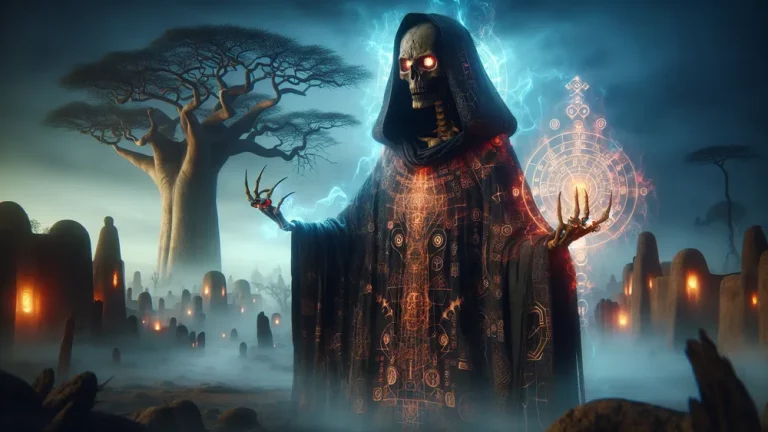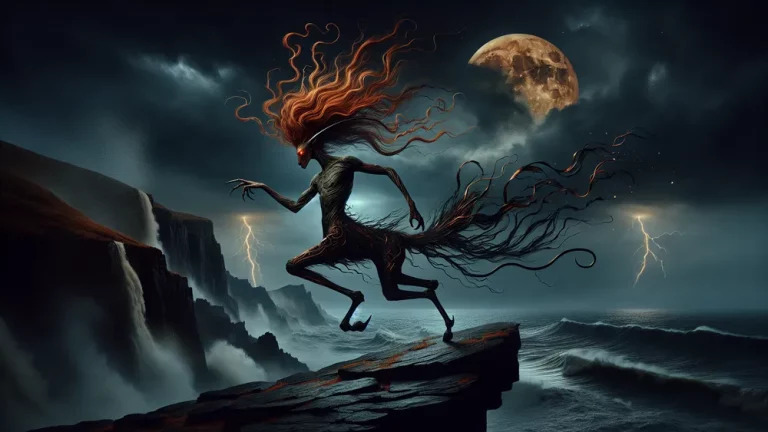Scylla: Greek Mythology’s Fearsome Sea Monster Guardian
Here, we take an exciting journey looking at one mighty sea monster from Greek mythology: Scylla. Covered in interesting stories from ancient Greece, she means a strong and risky force by the sea. Her story is full of different versions, in the way Greek tales were told by word of mouth.
Key Points:
- Scylla is a sea monster in Greek mythology guarding the Strait of Messina.
- She is often linked with Charybdis, making sea travel dangerous.
- Depictions in art show her as having dog-like features and many heads.
- Scylla’s origins differ, with parents like Phorcys and Ceto or others like Hecate.
- Odysseus met her in The Odyssey and lost crew members to her.
- Myths also tell she was transformed into a monster out of jealousy or revenge.
- Scylla continues to appear in modern tales symbolizing tough challenges.
Watching over the tight Strait of Messina, her story mixes with other myth figures like Odysseus, seen in Homer’s “The Odyssey.” These stories let you see deep ideas into how Greeks thought about nature and used monsters to mean real problems and danger.
You will not only know about her start and how artists have shown her, but also how people have talked about her through many stories. Whether you are new to myths or wanting more info, we welcome you to look into the fascinating stories around Scylla.
Getting to Know Scylla
To better understand Scylla, we look at her beginnings and the ways artists have shown her, which helps us know more about her important part in Greek myths. She was significant.
Where Scylla Comes From
Beginning before Homer’s time, Scylla’s start roots in old stories of both divine family lines and big myths about fear. In the book by Hesiod, called “Theogony,” it says Scylla comes from Phorcys and Ceto, they being two old-time sea gods, and this closeness with the sea is clear. But other stories talk about different parents like Crataeis or Hecate, meaning stories were flexible before writing started.
This confusion in where she comes from shows how early storytelling was mixed and varied, where many beings got their traits from different gods. It also means Scylla’s beauty, before changes, and her monster side. Scylla’s being mixes both nice looks and sea stories’ secret parts.
Where she changes a lot, in Homer’s “The Odyssey,” Scylla becomes famous not only as a sea monster but also as a forever problem for sailors, like Odysseus. In this tale, she gets one of her most known spots in Greek mythology: a feared challenge on the dangerous Messina Strait.
The way she is depicted in Homer’s tale helps much in her story, turning her from a not-so-known creature into a sign of danger and needing plans. As myths grew, her part changed in different texts, with each telling more about where she was from or her meetings with heroes.
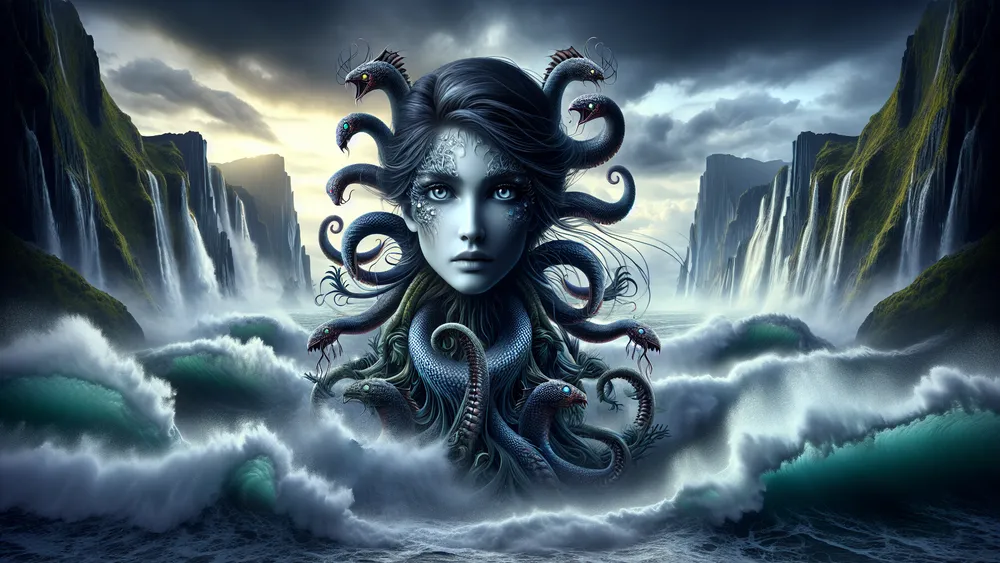
Understanding her journey in old tales lets you see how people from long ago used these stories to talk about the sea’s surprising power, maybe like how today’s ship leaders avoid risks by finding safer waters.
Scylla’s story, starting from ancient myths and evolving through various tales, shows how she transformed from a mysterious beauty into a legendary sea monster causing trouble for sailors, especially in Homer’s The Odyssey.
How She’s Shown in Art
In ancient history, Scylla’s many portrayals appear in ways showing how she is both complicated and dangerous. On Greek vases, for instance, her serpentine limbs and dog heads mean fear and wonder together in how they come from her waist. Additionally, Roman mosaic art includes her next to ships and sailors, showing her as part of sea stories all around.
Her strange and scary traits are clear in these old artworks, as they mean the wildness of nature like strong sea storms. In modern times, Scylla is still used as a symbol for sea risks in stories and pictures. This is similar to how scary movies use special effects to make people feel amazed and afraid.
What She Did in Myths
Now let’s look at Scylla’s mythological deeds. During legendary tales, she is where people felt this powerful sea creature most, and by examining these stories, her impact was big.
Scylla and Odysseus in The Odyssey
In Homer’s epic “The Odyssey,” the moment when Odysseus meets Scylla is one of the most frightening times of his trip. Amid the journey through the dangerous Straits of Messina, they had to decide between the scary threats of Scylla and Charybdis. Each was a tough danger. With her many heads and huge hunger, Scylla placed herself as a deadly problem, on one side, prepared to grab crew members.
Earlier, the goddess Circe had warned Odysseus, getting him ready for these unavoidable dangers, helping him prepare for this hard stage of his journey. She was clear with her wisdom: going near Scylla would mean losing just a few men, while Charybdis could destroy the whole ship.
This advice set the stage for Odysseus’s choice, a careful risk, kind of like how a leader chooses a lesser threat in battle. Odysseus made a choice that illustrated a key idea about leading and giving up for the greater good. In order to make it, he sailed closer to Scylla, choosing this hard path, which led to losing six crew members.
This is similar to how people in rescue missions might make hard choices – the safety of many often requires such choices. It reveals his strength and responsibility when times are tough, a necessary trait for those who guide others through very dangerous situations.
He thought carefully about:
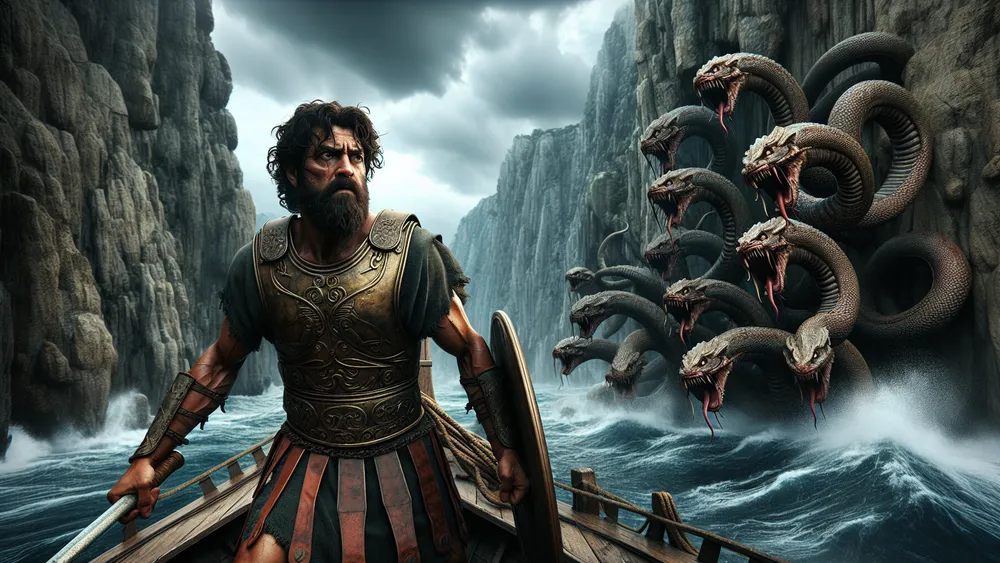
- Risking Less: Understanding it was safer to be near Scylla than Charybdis.
- Keeping Spirits Up: Making sure the crew stayed strong, even if he had to lose some.
- Following Wise Advice: Listening to Circe’s words, comparing divine help to what humans can handle. Odysseus crossing this part shows smart planning in very hard times, where his actions meant more than just staying alive, still shared in stories about good strategy and leadership today.
Other Stories and Myths
Outside familiar tales of Odysseus, Scylla is included in many lesser-known myths, meaning she appears in different old texts and stories. One well-known tale is in “Metamorphoses” by the Roman writer Ovid, where Scylla’s change into a monster is explained. First, as a pretty maiden, she becomes the subject of jealousy from the gods, a theme that continues in many old tales.
Her change happened because of a love triangle. It was when the sea god Glaucus loved her, and Circe, wanting Glaucus, got upset. After being turned down, Circe poisoned the waters where Scylla bathed, causing her to become the scary creature known to later sailors. Her change was tragic and complex, showing how the gods’ mood can affect fate, similar to how modern tragic stories talk about life’s unpredictable turns.
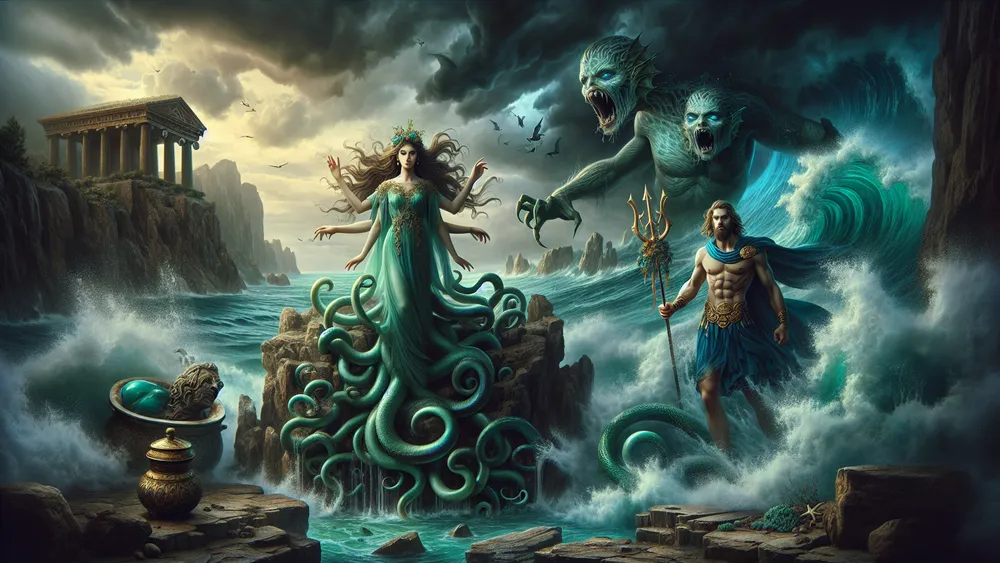
In addition to Ovid’s “Metamorphoses,” Scylla is also in “Argonautica” by Apollonius of Rhodes, about Jason and the Argonauts. Here, again, Scylla is a big danger on the heroes’ sea journey, showing her as a symbol of dangers in ancient Greek sea tales.
This means Scylla is the classic example of hidden dangers, like problems that occur unexpectedly during important tasks, reminding us that Scylla’s legacy is a symbol of challenges to face. The stories give a deeper look at Scylla beyond “The Odyssey,” making her a figure used by poets to tell stories about human challenges and fate’s changes.
Looking at the Differences with Other Sea Monsters
Now that we have Scylla’s tales clearly remembered, we consider how she is different from other tough sea creatures in old stories. Scylla appears unique.
Scylla and Charybdis Compared
Scylla and Charybdis are two of the most interesting parts of Greek myths, each representing something dangerous about sailing near risky shores. Charybdis is seen first, as a giant whirlpool that pulls in everything around it three times a day. This whirlpool means a powerful and unpredictable ocean force. On the other hand, Scylla shows the fear of dangers that seem impossible to avoid.
Remaining in one place, she waits, ready to grab sailors who get too close. However, she is like obstacles that keep us from moving on. Knowing these qualities makes better sense of the choices of heroes, like Odysseus, who had to move through these dangers.
Their meanings go further into stories, used as examples for choosing between bad options, similar to being “stuck between a rock and a hard place.” Their roles make the decisions in stories tougher, showing themes of hard choices and certain losses. To make these differences clear, here’s a simple chart showing what makes them distinct:
| Aspect | Scylla | Charybdis |
|---|---|---|
| Looks | Six heads | Huge whirlpool |
| Spot | On a cliff | In the ocean path |
| Type of Risk | Physical strike, catches sailors | Natural force, swallows boats |
| Significance | Cannot avoid, up close fighting | Nature’s anger, environmental troubles |
| Myth Role | Still hunter, keeps watch | Natural event, hard to handle |
These insights show how Scylla and Charybdis each play a unique role in Greek stories, each making their own mark in the symbolism about tough choices, unpredictable nature, and the feared parts of old sailing trips.
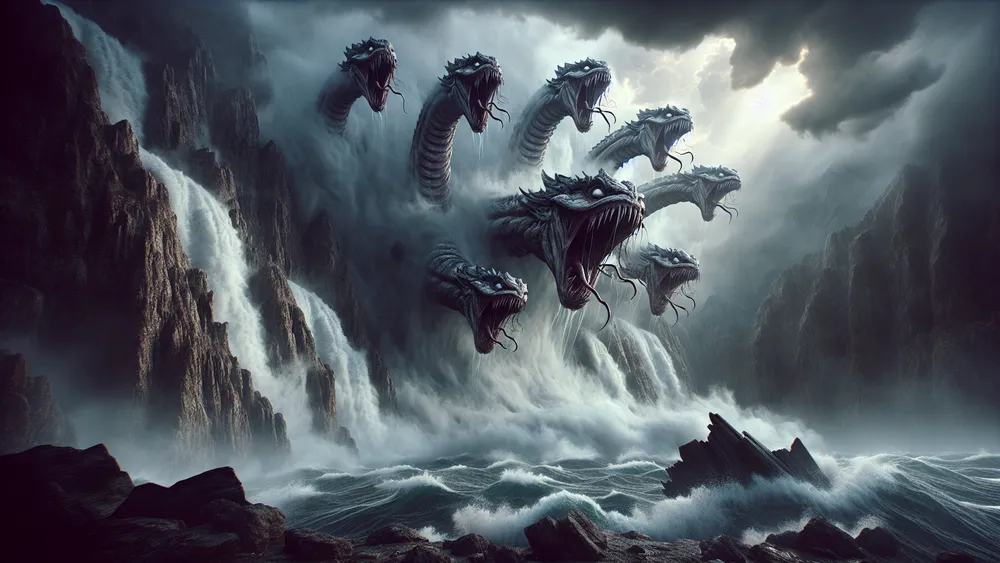
Scylla in Different Cultures
Looking at Scylla’s role in myths across the world shows interesting differences as old cultures tried to explain the wild powers of the sea. For example, in Egyptian stories, characters like Apep, which mean chaos and danger, remind us of choices sailors make when Scylla seems close in Greek tales. Apep isn’t a sea creature, but its connection with chaos means a common human feeling towards wild nature.
Meanwhile, Norse myths have Jörmungandr, a huge sea snake that goes around the Earth. This snake, which shows great power and danger, is similar to Scylla’s threat near the rocks. By looking at these beings, you can see how people everywhere try to understand the big forces around them.
In Roman stories, these themes are adapted too. Romans took much from Greek stories, yet also added their touches like Neptune, who rules over the waters, much like Poseidon. Roman stories would often keep Greek ideas of creatures like Scylla, making them part of their own beliefs. In Roman tales, Scylla and other sea dangers were parts of the Roman view of the sea’s vastness. Here are some matching myth characters from different cultures:
- Egyptian Myths: Apep (not really from the sea but relates to chaos)
- Norse Myths: Jörmungandr (a big sea serpent around the Earth)
- Roman Stories: Neptune’s sea problems carry on Greek ideas
These connections between cultures reveal not only the sea’s unknowns but also the shared themes in human stories through time, explaining the power and unpredictability of their surroundings.
The world’s myths all touch on sea mysteries by using creatures like Scylla, blending local tales with shared fears and respect for nature’s power.
How She Affects Our Culture Today
After we have looked at Scylla’s mythological roots and her many connections in old stories, we now check out her lasting effect on modern stories and media. Her presence remains strong.
Scylla in Today’s Stories
Scylla is scary in today’s stories, redesigned in various places while keeping her old roots. Her picture usually stays as the strong image from old Greek tales, but you also see her in new fantasy books, big movies, or TV shows.
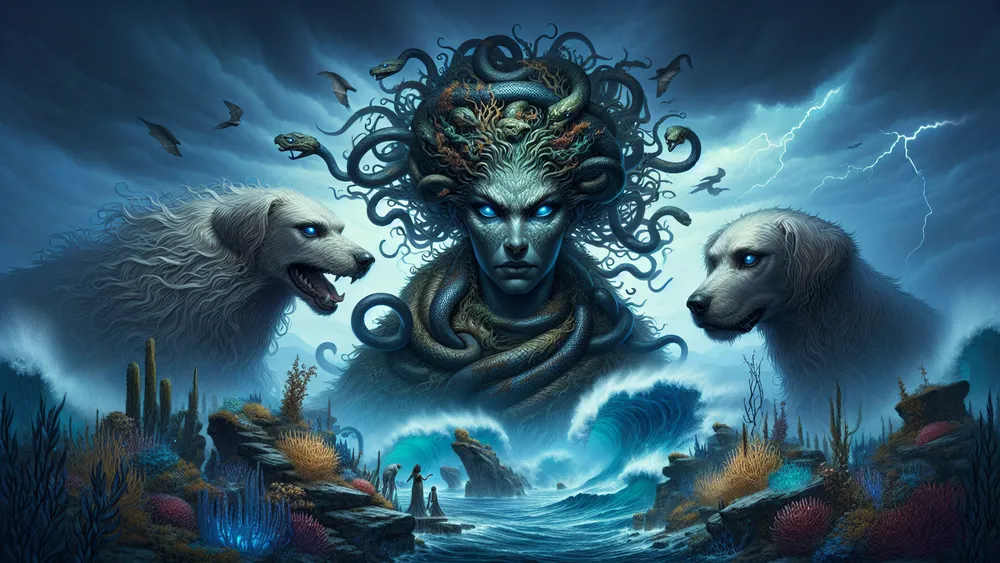
For example, a film might have a creature like Scylla, using her famous fear and inescapable danger to make viewers tense, which fits movies about big sea troubles or challenges. Also, in books and games, Scylla means a hard-to-beat challenge, pointing to her as a symbol of tough problems. Scylla still means a lot, and she keeps pulling in audiences, much like she did long ago, connecting ancient and new stories.
Pantheon of All the Greek Mythology Creatures and Monsters
The world of Greek mythology is full of many beasts and monsters, each bringing their own style to old stories that have interested societies for ages. These beings are different; some are very scary like the Minotaur and Medusa. However, others are more magical, like Pegasus, helping to build the wide world of these stories.
If you want to know more about this interesting area, there is a list of all the Greek Creatures and Monsters where you can look at all types of beings that have been a big part of Greek storytelling, showing different parts of these imaginative wonders. They are fascinating.
FAQs
1. What is the origin story of Scylla?
The origin story of Scylla in Greek mythology varies, but it commonly attributes her birth to sea deities Phorcys and Ceto, and she was transformed into a monstrous creature through a curse linked to envy or vengeance.
2. How did Scylla become a monster in Greek mythology?
How Scylla became a monster in Greek mythology is often attributed to being transformed by the jealousy or vengeance of a deity, usually Circe or a similarly powerful figure, who cursed her out of spite or rivalry.
3. What was Odysseus’s strategy against Scylla?
Odysseus’s strategy against Scylla involved instructing his crew to row swiftly past her lair while he avoided engaging directly, as the decision was made to minimize overall casualties by not confronting Scylla head-on.
4. How is Scylla depicted in ancient art?
Scylla is depicted in ancient art as a monstrous creature with a female torso emerging from a writhing mass of canine bodies, often accompanied by images of her devouring sailors.




